One of the foremost incentives for purchasing my own grain mill was rye.
From coarsely milled rye grains soaked and added to wheat dough, to freshly milled flour and a thriving rye starter.
Rye has been on my mind this week … probably a little too much to be called healthy. So with some free time available last night, I shifted thinking into practise.
Rye and Mixing
[url=http://www.flickr.com/photos/67856223@N06/6259861965/]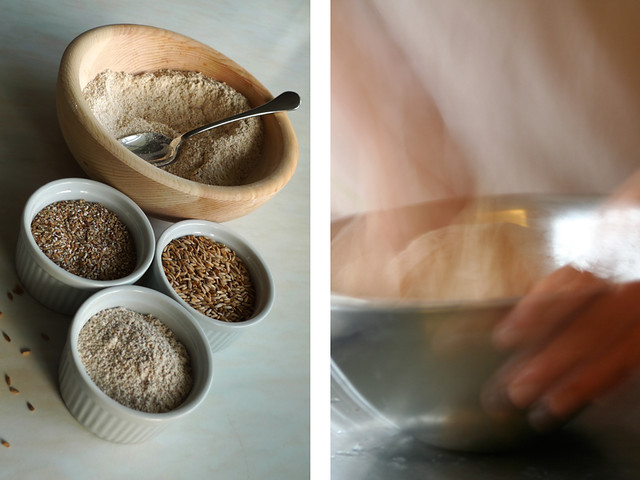 [/url]
[/url]
The first bread is a Dark Sour Rye. The formula is kind of pieced together from bits of knowledge and tips gathered from around the web (namely Danubians formula) This was the first time baking rye in my 8x4x4 pullman pan so quite a bit of guess work went into the amount of dough required to fill it…this will be an ongoing process as I was a still little short on the correct amount.
Dark Sour Rye
[url=http://www.flickr.com/photos/67856223@N06/6260389726/]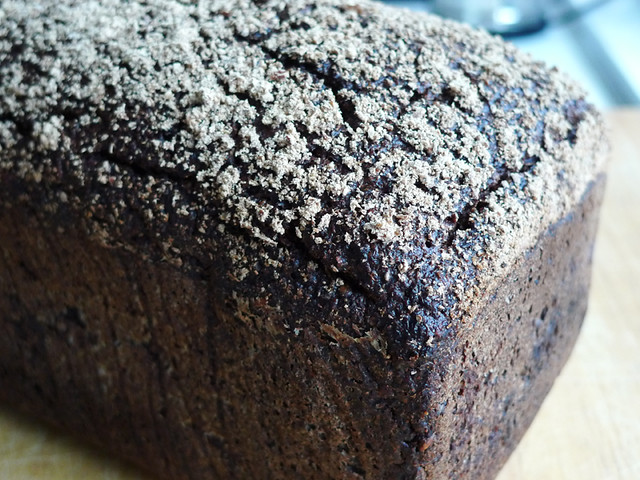 [/url]
[/url]
Total dough weight: 3kgs
Hydration: 85%
Prefermented Flour: 35%w
DDT: 29°C
Day before
Rye sour (20hrs @ 28°C)
Starter: 30g
Freshly milled rye flour: 612g
Water: 690g
Morning before
Soaker (12hrs @ 20°C)
Cracked rye: 525g
Water: 525g
Final Dough (29°C)
Rye sour: 1224g
Soaker: 1050g
Freshly milled rye flour: 613g
Water: 275g
Salt: 35g
Bulk ferment for 30 mins. Using wet hands, divide, scale, shape and then place into greased tins seams down dusted on top with flour
Prove for about two hours
Bake in steamed oven at 250˚C for 10 mins then turn down to 190˚C and bake for a further two hours. Turn down to 150˚C bake for one hour. Turn down to 100˚C and bake for a further two hours with oven set to auto shutoff and allow to cool in oven until morning.
We went to bed with the heady smell of caramelised rye pervading the house … it seemed like it was even throughout my clothing.
Oiled and wrapped
[url=http://www.flickr.com/photos/67856223@N06/6259862423/]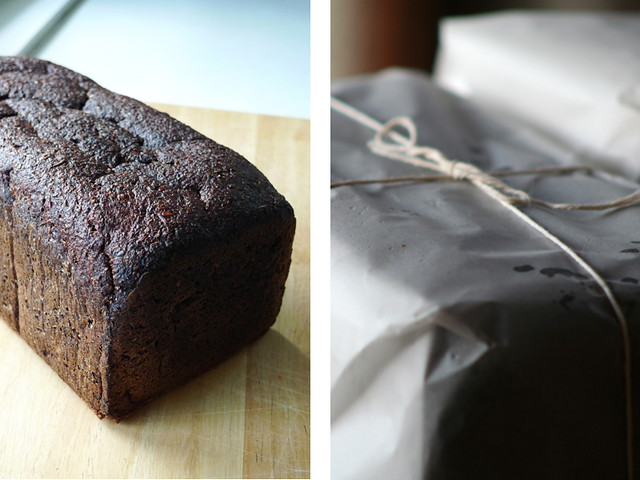 [/url]
[/url]
When I arose in the morning the tins were still warm and the bread was a heavenly dark chocolate colour. I brushed them with grapeseed oil after cooling, wrapped them in paper and set them aside for the excruciating long wait until cutting. I also realised late into the bake that I had neglected to dock the larger loaf so I am expecting a flying crust … to be continued ….
The second dough was an experiment in using my rye starter on a sifted wheat bread and overnight rise in the fridge. It was time to get out of my comfort zone as I have been hesitant to retard the dough for fear of over proving. I also used a fair sized portion of soaked cracked rye for some added texture to the crumb.
Quite Light Cracked Rye
[url=http://www.flickr.com/photos/67856223@N06/6260390226/] [/url]
[/url]
Total dough weight: 1kgs
Hydration: 82%
Prefermented Flour: 15%
DDT: 24°C
Soaker
Morning before (12 hrs)
Cracked rye: 66g
Water: 66g
Final Dough
Freshly milled rye starter @ 110% Hydration: 173g
Sifted freshly milled wholewheat flour: 467g
Soaker: 132g
Water: 293g
Salt: 12g
Milling Wheat
[url=http://www.flickr.com/photos/67856223@N06/6259863617/]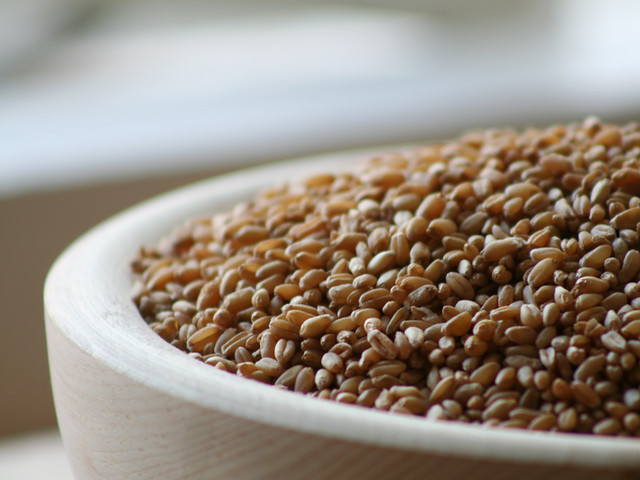 [/url]
[/url]
Autolyse flour and water for one hour.
With wet hands squeeze and incorporate starter into dough until smooth and feel no lumps then knead for 10 mins (I use slap and fold). Rest dough for five mins. Incorporate salt and soaker and knead for a further five mins.
Bulk ferment three hours with three stretch and folds 30min apart in the first 1.5hrs.
Preshape. Bench rest 20 mins. Shape.
Final proof was roughly 30 mins at room temperature (23°) then into fridge for eight hrs.
Bake direct from fridge in preheated dutch oven for 10 mins at 250°C then a further 20 mins at 200°C. I them removed it from dutch oven and baked for a further 30 mins directly on stone for even browning.
[url=http://www.flickr.com/photos/67856223@N06/6259863175/]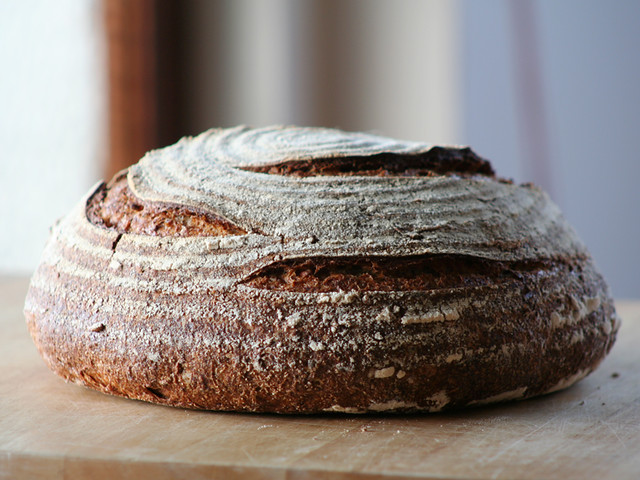 [/url]
[/url]
[url=http://www.flickr.com/photos/67856223@N06/6259862979/]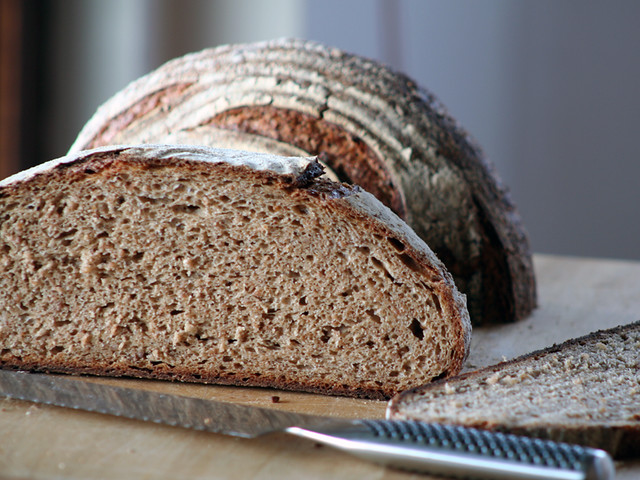 [/url]
[/url]
[url=http://www.flickr.com/photos/67856223@N06/6259863423/]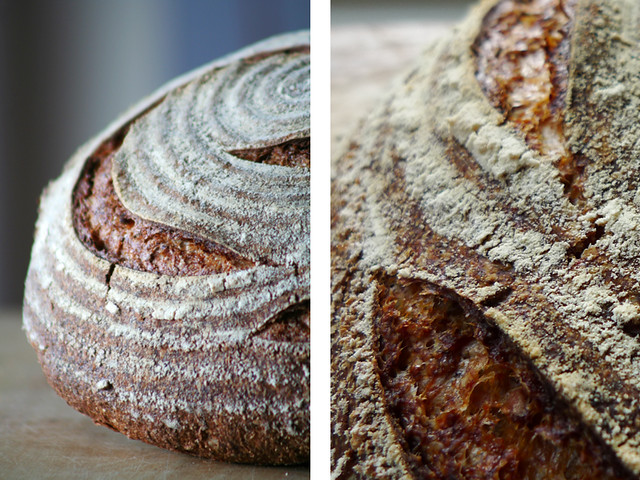 [/url]
[/url]
When my daughters arrived home after school and spotted this loaf I was quickly instructed to cut them a slice. The cracked rye was hidden away in the crumb from there prying eyes. It was demolished. Best crust I have had made for a while.
This bread has tang. Not overpowering, but lingering. The cracked rye is soft and barely registers in the mouth.
On a side note...with the formulas, would everyone prefer I use bakers percentages, weights or both. I am writing these the way I construct them, which I understand may not be the best for all people.
Cheers, Phil
** Update
[url=http://www.flickr.com/photos/67856223@N06/6264122453/]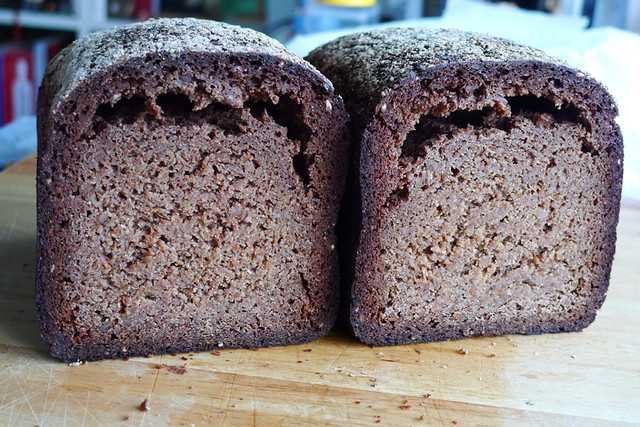 [/url]
[/url]
Well as expected my undocked loaves "lost their roof". If any experienced rye bakers have any clues that would be greatly appreciated. I know when I did this bread a few years ago I had the same issue and I think docking fixed it....thoughts?
Tastes fantastic. Dark, rich and quite sour ... but I am not happy with flying crust and I will bake for less time. Crust is not tough just too much colouring on outside of the loaf while lighter inside.
Cheers, Phil
- PiPs's Blog
- Log in or register to post comments
Wonderful Bakes, Phil! The dark rye loaf is well worth the effort. waiting to see a crumb picture.
As to the light rye, now that is one of the most beautiful scoring i've ever seen on a bread!! Lovely work, and you picrture makes it even more inviting. very inspiring effort, Phil. Best of all, they are all very healthy. No wonder your daughter is addicted to such breads!
No worries about the formulas, you even make them look simpler than they are.
Nice work!
Thanks,
My kids can spot a grain or seed in a bread a mile away and usually turn there noses up. The cracked rye was camouflaged ... very sneaky on my part. They had no idea. :)
I am quite anxious to see inside the Dark rye ... will be breakfast tomorrrow ... oh the waiting.
Phil
Beautiful - your photos are excellent, very evocative - and such lovely scoring, very impressed!
Beautiful breads and gorgeous phtography!
I have really been enjoying your posts, and this one is no exception. I have been on the fence about home milling, but you are helping to push me in that direction. Thank you for your contributions.
Alan
Thanks Alan,
Granted, home milling is not for everybody and it was quite some time before I committed the time and money for it.
Saying that, everybody who has seen the Komo mill and tasted fresh flour straight after milling have been astounded at the difference with it from supermarket/packaged flour.
Even my father has bought himself a small Hawos stone mill for the bread he makes with his bread machine. He sent me this photo last night of his second loaf made with fresh milled flour.
Dads bread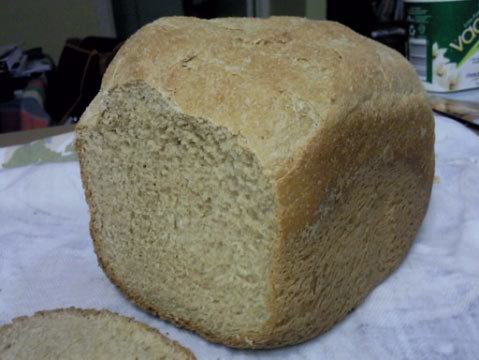 [/url]
[/url]
[url=http://www.flickr.com/photos/67856223@N06/6261680939/]
of the light rye, but it all looks terrific. -Varda
Wonderful loaves and beautiful photography, as always. :)
Love the way you scored the light rye.
to see the crumb of the rye bread and to read your opinion. Bread made with freshly ground rye must be uncomparable. Did you bake it covered or uncovered? I guess the former given the baking lasted 5 hours.
The light rye is mouth-watering, too!
I am half excited, half terrified about seeing the crumb ... It smelt incredible cooking and looks great but you never know until you cut it and try it :)
One the loaves was baked in a pullman pan and was kept covered the entire time. The second loaf was uncovered for the first two hours then covered with foil for the remainder. I forgot to dock the uncovered loaf (hate it when I do that) and have a feeling it has popped the top crust.
I agree on the awesomeness of fresh-milled rye. I use at least 5%, just for flavor, in most breads that I make.
Hi Phil,
Lovely rye breads, and the scoring on the boule - gorgeous!
Wow, your photos and writeup are making me want to go out and buy a grain mill :^)
Re: scaling for 8x4x4 pan, I tried 780g dough weight (guessing) for a small Vollkornbrot I made a little while ago
(Mr. Hamelman's formula); I am curious how much dough you scaled for your pan, for comparison?
Re: side note, if you are willing to note baker's percentages in your posts - I'd like that :^)
With thanks from breadsong
Oh yeah, the smell was intoxicating :)... but in a good way.
I was trying to fill the pullman completely (square corners) so scaled up Danubians suggested 1kg (for a smaller pan size) to 1.35 -1.4kg - Will go slightly higher next time ... a learning experience.
No worries, I will throw some bakers percentages in next time. I guess I write them like I work them out.
1. start with desired dough weight
2. what hydration I am aiming for
3. amount of prefermented flour and preferments hydration (dependant on temperatures and timelines)
4. Work out the remaing formula from there
Cheers, Phil
@varda: Thanks, Tried to step out of my comfort zone again for that ... phew ... it worked :)
@Salilah: Cheers, I had some really nice lighting in the afternoon which helped.
@lumos: Thanks Lumos, still no cocoa powder in my breads yet :)
@loydb: Totally agree, It makes such a difference. I am not a fan of completely white breads though ;)
Your breads are magnificent, as is your photography. What is it about Queensland? First Shiao-Ping's boundary-pushing bakes, and now you! (I know you're relatively new to TFL and may not be familiar with SP's posts, but believe me, I'm paying you a compliment of the highest order).
Your skills as a photographer (and baker!) are doubtless the main factor behind your terrific pics, but interested to know what sort of photographic equipment you're using. And is the lighting all natural? Keen to know some technicals if you don't mind divulging them.
Cheers!
Ross
Gday Ross :)
Thanks, that is quite a compliment. Shiao's posts were a constant favourite of mine (hope she is still baking) ... boundary pushing is a perfect description.
I probably wouldn't describe myself as a photographic guru :) My day job however, is a graphic designer, so I maybe have an eye for that sort of thing. My partner is a graphic designer also, and she has a fantastic eye ... lots of helpful feedback :)
Also, my father used to play alot with cameras and would often convert our bathroom into a darkroom.
I'm not using fancy gear at all. I am using a Panasonic Lumix point and shoot (DMC-LX3) for some of the shots and occasionally borrow an old Canon digital SLR (350D) with a telephoto lense and tripod.
All my favourite photos were shot using natural lighting (morning or afternoon is best) with a telephoto lens set to large aperture (f5.6) getting as close to the subject as possible.
Always use natural light, photos near a windows are good. Use light curtains if you are getting direct sunlight. I am lucky that I have lots of windows and a light filled kitchen.
If its any consolation, I had to go on the web and research photographic terminology for this posting to make sure I had the terms right :) ... as I said I am not a photographic geek ... just love taking these kind of photos.
With the enjoyment I am having doing this and the great feedback, I am very close to purchasing my own entry level digital SLR ... just have to cough up the cash which is always a bit hard to do :)
Cheers, Phil
I have the Panasonic DMC-LX5, so very similar to yours.
I already do the things you mention (utilise morning and afternoon light etc) and although I do get some nice pics I am happy with, not many are as consistently professional-looking as yours. This is partly because too often I don't take much time or care over my pics, but still...
One more question, pls: do you use the iA setting or P, or some other?
Cheers
Ross
I'll admit, I have to struggle alot more to get an image I am happy with when I use the Panasonic. Its a great camera, and takes lovely sharp images, problem being it has almost no zoom which makes it a little tricky to get the kind of shots I am after. I usually keep it on iA or A for Aperture priority.
Cheers, Phil
Aha! I use Panasonic LUMIX! I'd been taking bread photos with 'Food' in scene options, but recently found iA takes much better picture. Still trying to learn the rope since I started blogging here. Had never used a camera so intensively before! :p
Also, I usually only take the picture in daylight, too, because the colours get weird if taken under night lights.....though I've very recently noticed if taken under the halogen lights of the extractor, the colour is so unnatural as other lightings. It's still not quite natural, but better.
The example of three photos taken under different lights, here, in my latest blog.
The first pic was actually taken the following day under natural light mid-day.
The second one was under the halogen lights of the extractor.
The third one was taken soon after baked in the evening, under the lighting in the kitchen.
All the rests were taken next day under natural light.
Thanks Janet,
I am a serial underproofer :) I am getting better at judging the breads. (how they look, how they feel, keeping an eye on dough temperatures and records of past bakes)
I still err on the side of caution with the wholegrain breads though, and tend to have the best results with oven spring using the dutch oven as I can't turn off the fan in our oven.
I use a homemade lame (razor on a piece of bamboo) and a small tomato knife. I prefer the sharp razor, but the tomato knife is pretty effective too. I don't think I score that differently with wholegrains. I probably make more of a judgement on how the dough is looking i.e.under or overproved and score accordingly.
Those chocolate breads sure are popular :)
cheers, Phil
Beautiful Loaves!
Lovely crust crack expansion on the bottom of the crescent slashes of the light cracked rye. Looks naturally controlled by the curve possibly being repeated and exploited.
When I see all that caramelized rye in the slash and what subliminally appears to be excaping or dripping down or bursting, my rye sensors go nutty! :)
Thanks Mini oven,
Now let me guess ... your a fan of rye breads ;)
Read my mind.
I am making them again ... two loaves. One with store bought rye the other with Fresh milled. I am using the same soaker for both and I added salt in it after reading a few posts on "starch attack". The fresh milled rye behaves very differently to the store bought flour especially in the starter. I will post some photos next week which show what I am talking about.
Great suggestion for the "unmentionable" bread :)
Cheers, Phil
WOW, Phil...! I don't even know where to start with congratulations! breads, photos, scoring, nice write-up, attention to details?! your work is precious and spectacular, and I'm truly impressed. When I opened your post today, the first thing that came in my mind was: I want to bake something like that. I want to take pictures like that. After I read your post, I thought: I want to taste those. :)
Baker's percentage would be nice, it's easier to scale.
<I have some naive questions. What is cracked rye? If I can't buy it, can I make it? (I assume it's not the same thing with rolled rye) And because I asked that, I will ask something more, unrelated with your post. What are rye chops? I have a guess what they are, but can I make it at home? (unfortunatelly, I can't find/buy something like that here). I can buy rye berries. If I crush some berries I'll have cracked rye? if I soak some berries and then chop them I'll have rye chops? is that simple? and How do you chop them without cutting your fingers or making them fly all over the place? End of my naive questions>
It's a pleasure to see/read your bread stories.
codruta
Thanks so much Codruta, i'm very flattered.
I find the different grades and names of rye very confusing. In Australia we don't seem to have the same amount of variety that I have read about overseas. Chopped rye is made from rye berries that have been cut or kibbled through corrugated grinding rolls or steel cutters. You could run the berries through a coarse setting on a grain mill and it might give you roughly the same but with a bit of flour created from the process as well. I imagine that cracked/kibbled rye should be available but might just take some time to order it. If its not available a grain mill with an ability to grind coarsely would be the way to go (an expensive option though). Using a knife sounds like a pretty risky scenario to me :)
Cheers, Phil
Hi Phil,
I'm a bit late to the party and can only echo what the other members have already said about these two fine looking rye breads of yours and your post in general, but I can say I've thoroughly enjoyed both the writeup and photos of all your posts so far. I've been thinking of adding a milling attachment to my mixer for a while now, with your posts giving me plenty of incentive to dive in to that aspect of home baking.
Nothing quite like the aroma of a slow baked, all or high ratio rye bread is there? The first time I made one our house held the scent of it for almost 48 hours afterwards, which I thought was a nice bonus to the bread itself. Sorry to see the loaves "lost their roof" but the crumb looks very good, as does the crust. I'm not a rye expert by any means, but I remembered reading a post of a similar problem last year that Andy/Ananda (a true rye expert) responded to and thought I'd send it on to you FYI, in hope that it may be of use to you. Nico has a very interesting observation regarding roof collapse and acidity level as well.
http://www.thefreshloaf.com/node/18441/first-100-rye-sourdough-ok-outside-hollow-inside
Looking forward to your next post!
Franko
Thanks Franko,
Those links are great. So my take on it is this. The sour should have been acidic enough (can it be too acidic?) It was turning to goo in the middle of it when I added it to the dough. I think I just overproved the loaves and forgot to dock which didn't help my cause.
I am going to bake this again and I am going to get it right :) ... maybe ... hopefully?
I am going to ditch the bulk ferment, I don't think its necessary. I am going watch the dough more closely as it proves ... AND I am going to dock it.
Oh and I just found this quote from Andy
mmm ... lots to ponder....my milled rye flour is very thirsty. Might do a bake test with some store bought rye flour as well.
Phil,
the flour that Andy talked about was a flour with a high percentage of damaged starches, something that happens when you mill the flour superfine. Juding from the picture of your flour in the bowl I don't think it's your case, but only you can tell. The loss of the roof is -in my opinion- only the smallest of the two problems you had, the other being the very compact and gelly structure of the crumb that looks very moist (is it)? I experienced your very same problem whenever I prepared the bread with a high percentage of fine flour and baked it for many hours. What happens -if my understanding of this complex matter is correct- is that during all those hours at low temperature amylases breaks starches to maltose, glucose and dextrins, all molecules that dissolve in water causing a loss of consistence of the dough and literally a meltdown thereof. For baking like this one either you need a very acidic dough (and it's not even a warranty of success, IMO) or you need to replace almost all of the fine flour with schrots/groats (that need at least one whole day of fermentation to soften acceptably. Too little and your bread will crumble hideously when slicing). The roof loss is just a consequence of a series of problems (maybe steam accumulates within the dough and cause a push upwards).
When using a high percentage of fine flour the ideal baking is performed at very high temperatures, even 250°C (if not more) in the initial minutes.
I see that Andy has been away for a while, that's why I jumped in. I hope he'll come back soon to clarify the matters much better than I did, hopefully correcting my eventual BS :-)
Thanks nicodvb,
Given me lots to think about. Well I am going to make this again. A test bake. Try a control bread using store bought rye and another with fresh milled. I have made a soaker with more a bit more flour in it this time and used salt in the soaker as well as I read this will help contain the amylases. I have made two seperate sours each with different flours. They behave very differently. I am not sure if it just the fineness of milling, but the store bought flour sour is rising higher with even bubbles throughout, while the fresh milled is lower and with really uneven and coarse bubble structure.
Maybe I am a bit dubous about my milled flour. I have made this bread before without issue.
I will bake at a hotter temperature initially as well as docking.
Phil,
I don't know if in AUS it's the same, but store-bought flour down here is not really wholemeal even when it's declared as such (with only one exception that I know of). A part of the bran is surely sifted off and the thing shows from the color of the poolish: it's lighter than an equivalent poolish made with home ground rye. Both the bran and the fineness influence how much the dough can rise.
I think your right on this. The rye flour I am buying would be roller milled. I have a coarse sieve, that might be worth investigating as well.